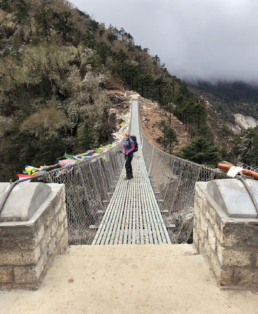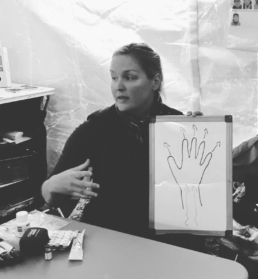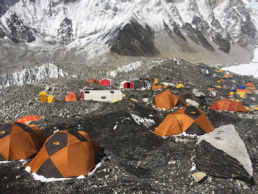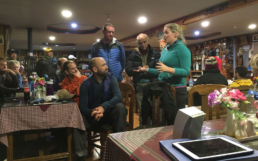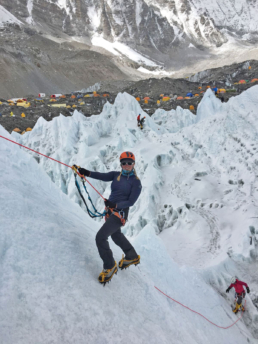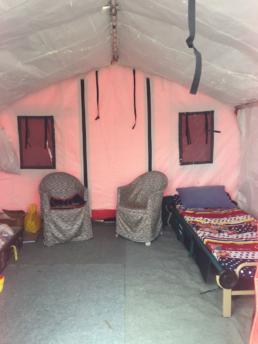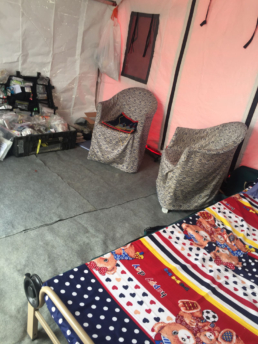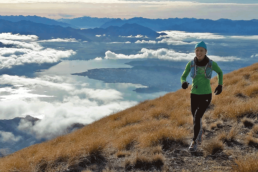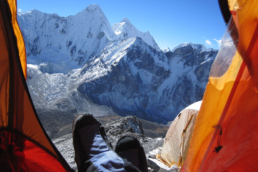Everest Insider Series - Part 1 : Dr Sophie Wallace
In the first of our Everest Insider Series, we delve into the unique world of high-altitude medicine with Dr Sophie Wallace, Adventure Consultants’ Medical Advisor and Expedition Doctor. An experienced emergency physician, Sophie has just concluded her third season at Everest Base Camp and shares her insights into the challenges of expedition life and the realities of working in what must be one of the world’s most remote medical centres.
What is your role with Adventure Consultants at Everest Base Camp?
I’m the team doctor here for the Everest climbing season. My main role is to look after and prevent any medical issues with the climbers and Sherpas, but we also have a large number of trekkers on different trips throughout the season as well, so I’m on hand for medical treatment either in person or via radio consult if they are not in the area.
How did your background lead you to joining with Adventure Consultants in this role?
I first climbed Kilimanjaro as a medical student when I was 19 and became really interested in the medicine and the incredible physiology that goes on at altitude. Since then I’ve spent a lot of time pursuing a special interest in altitude and mountain medicine as well as developing my own climbing career and have been able to combine medicine and mountains since my first trip to the Himalaya as a doctor in 2009. I first joined the Adventure Consultants team in 2014, which sadly was a tragic year for Nepal and the Sherpas, and this is my third season working for Adventure Consultants on Everest. My specialty as an emergency physician is a great background for dealing with any of the spectrum of problems than can arise on a 9-week expedition.
What is your personal climbing and outdoor background?
We’ve been hiking and climbing as a family since I could walk, and the garage at home always had walking boots in every size from toddler to teenager for myself and my 3 sisters! My parents are very active in the outdoors even into their 60s and 70s and with a Scottish father and Swedish mother the mountains and the outdoors were always part of our life. My first high altitude experience was when I was 19 climbing Mt Kenya and Kilimanjaro, and as a family we hiked in Ladakh in the Indian Himalayas together. Things took off from there and I have now been on 6 Himalayan expeditions, climbed Kilimanjaro twice, Mt Elbrus, and almost made it to the summit of Aconcagua. Failing a summit is such a valuable lesson and I took away so much from that trip. I also try and get over to New Zealand as much as possible – the climbing there is wonderful and a great technical playground for developing more complex climbing skills.
What are the best parts about your job?
Having a role in helping someone achieve their dream of standing on top of Everest is such a privilege. I love spending lots of time at the beginning of the season really getting to know the clients and what their personal background and drive is. Understanding the motivation and psychology behind the climber can really help you to help them.
I love educating the team about altitude medicine too – prevention is better than cure and if I can help people to keep themselves healthy then I won’t have to treat the severe aspects of certain conditions like altitude illness or frostbite, which are so preventable.
Also, having Everest Base Camp as my office and the Khumbu icefall as my backdrop is just magical, and becoming friends with the Sherpas and local Nepali staff is a joy.
What are the hard bits and how do you cope?
Spending 9 weeks in a sleeping bag, in the cold and being on-call 24/7 can be a challenge. Keeping your sense of humour is so important, having little treats (I bring a really nice face cream!) and reminders of home helps, as well as making sure you get enough of your own downtime and personal space.
Learning not to rely on familiar tools like X-rays or blood tests and having to make decisions for people based purely on clinical skills has been difficult at times, but you just have to make a judgement call and hope you’ve done the right thing.
Possibly the worst part is having to send a client home either for medical reasons or just because they are not strong enough or not coping with what’s required for them to be safe – I’ve shared tears with clients in their tents or on the helipads when we’ve had to make a call like that. You want everyone to succeed in their dream but inevitably that’s not possible and it’s hard.
Tell us about how it works, having two cultures, east and west, work together to bring about successful results every year?
There is such mutual respect I think, and that goes back decades. It’s impossible not to respect the incredible work the Sherpas do, carrying huge loads to the higher camps in order for the clients to have as comfortable an experience as possible. Many of the Sherpas here have worked for years and there’s nothing they haven’t seen. I think the clients can’t help but be in awe of them and the mutual trust between the two groups is essential – you are placing your life in the hands of people who know and love this mountain and would do anything to keep you safe. Culturally there is a bit more of a shift with the younger Sherpas who are less shy, and keen to improve their English or become your Facebook friends which is lovely, and the older generation are more reserved but so wise and experienced. At the end of the season it’s so lovely getting everyone together to celebrate.
What do you miss most about home life?
My en-suite bathroom and going to bed feeling warm! I miss my family, especially my nieces and nephew.
I thought I’d say I miss some foods but the food here is so fantastic I have very few cravings other than a nice cold glass of milk!
Living on the side of a mountain on a glacier, can have its moments? What stands out to you?
Listening to the cracks and rumbles in the icefall and hearing the avalanches day and night is something else.
But the most magical part is getting up in the middle of the night to go to the loo and looking up at the night sky. It’s incredible. I turn off my head torch and just look up at the stars, the Milky Way and the millions of diamonds in the sky and see the train of head torches going up the Khumbu icefall with the shadow of Everest and Nuptse backlit by the moon. I could look up at it all night if I didn’t get cold! It really is a million-star hotel.
Related Posts
November 8, 2017
The North Face Adventure Grant 2018
May 30, 2017
Fit To Climb
March 1, 2017

